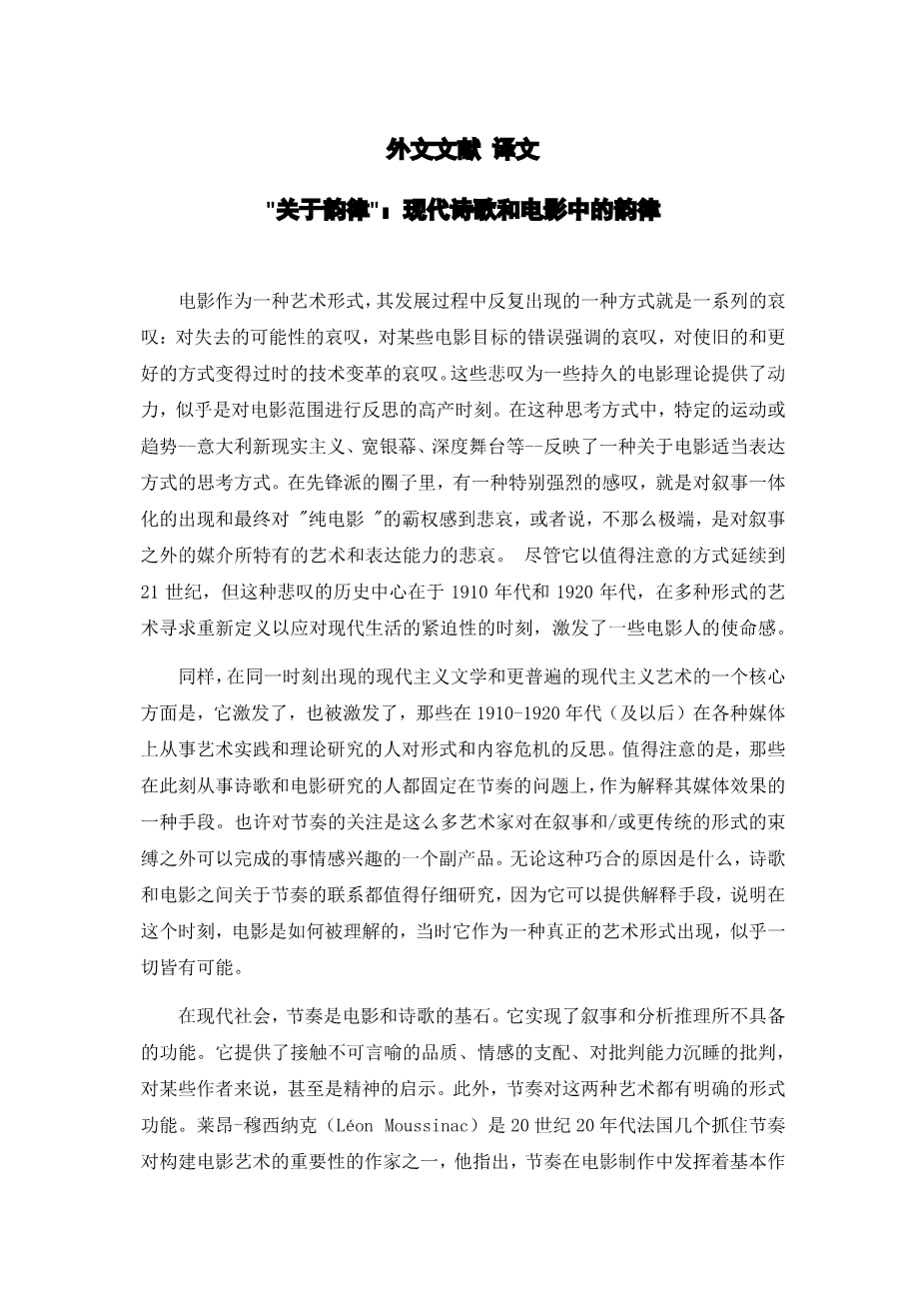“As Regarding Rhythm”: Rhythm in Modern Poetry and Cinema
Sarah Keller
Abstract
This essay examines the connection between modern poetry and cinema through their mutual emphasis on rhythm. It argues that rhythm provides both an alternative mode for structuring non-narrative cinemas as well as an explanatory device for how filmmakers in the modernist milieu believe the cinema works.
One of the recurring ways in which the story of cinemarsquo;s development as an art form has been told involves a series of lamentations; over lost possibilities, over wrong emphases on certain cinematic objectives, over technological changes that have rendered the old and better ways obsolete. Having fueled some of the enduring theories of the cinema, these lamentations appear to arise as highly productive moments of reflection on the purview of cinema. In this manner of thinking, specific movements or trends—Italian Neo-Realism, widescreen, deep staging, etc.—reflect a way of thinking about the cinemarsquo;s proper means of expression. One particularly strong lament periodically arising in avant-garde circles grieves the emergence and eventual hegemony of narrative integration over a “pure cinema,” or, less extreme, over the artistic and expressive capacities uniquely available to the medium that lie outside the zone of narrative concerns.[2] Although it continues in noteworthy ways into the 21st century, the historical center of this lament lies in the 1910s and 1920s, galvanizing several filmmakersrsquo; sense of purpose at a moment when art in its many forms sought redefinition in response to the exigencies of modern life.
Equally so, and arising at the same moment, a central aspect of modernist literature and of modernist art more generally is that it inspired, and was inspired by, reflection on the crisis in form and substance for those practising and theorizing art across a variety of media in the 1910s-1920s (and beyond).[3] It is worth noting that those working on both poetry and cinema at this moment fixate on the question of rhythm as a means of explaining the effects of their medium. Possibly the focus on rhythm is something of a byproduct of so many artists interested in what can be accomplished outside the stranglehold of narrative and/or more traditional forms. Whatever the reason for the coincidence, the connection between poetry and cinema regarding rhythm deserves scrutiny for what it can provide by way of explanatory device for how the cinema was understood at this moment when everything seemed possible for its emergence as a genuine form of art.
Rhythm serves as a cornerstone for both cinema and poetry in the modern era. It achieves functions not available so readily to narrative, nor for that matter to analytical reasoning. It proffers access to ineffable qualities, emotional dictates, criticism against the slumber of critical faculties, and for some authors, even spiritual revelation.[4] Furthermore, rhythm serves a definitive formal function for both arts. Leacute;on Moussinac, one of several writers in France in the 1920s to seize upon the importance of rhythm in constructing cinematic art, notes that rhythm fulfils a fundamental role in filmmaking: “To edit a film is nothing more than to give it rhythm.”[5] Like others in his milieu, Moussinac connects cinema both to poetry and to other arts, most particularly music, in his consideration of its proper means of expression, linking the “symphonic poem” with the “cinegraphic poem.”[6] Modern poetry, keenly focused on the issue of rhythm, likewise summons musical analogies to its aid in describing the proper use of rhythm for poetic impact. The three cardinal tenets of Imagism as expounded by Ezra Pound, one of the most prolific proponents of rhythm as an aesthetic principle, conclude by highlighting the role of rhythm vis-agrave;-vis music in the construction of modern verse: “As regarding rhythm: to compose in the sequence of the musical phrase, not in sequence of a metronome.”[7] Pound frequently returns to the idea of rhythm relative to music to argue for effective methods of poetic phrasing, as we shall see.
The charm of a poetic model for cinema is that it grants a point of access for thinking about some of the cinemarsquo;s power that is not fully accounted for in other models. John Hollander (among many others) has noted that there is a strong relationship between poetry and music and other oral traditions, as well as between poetry and the ineffable or magical (its incantatory powers): “Poetic form as we know it is an abstraction from, or residue of, musical form, from which it came to be divorced when writing replaced memory as a way of preserving poetic utterance in narrative, prayer, spell, and the like.”[8] Other poets have noted the ability of verse to transfer feeling to the reader. Louis Zukofsky, for instance, argues that “[t]he music of verse carries an emotional quality; when the music slackens, emotion dissipates, and the poetry is poor.”[9] T.S. Eliot provides an important note of caution for this view, assuring us that the musicality of poetry is not its only important quality: “I would remind you, first, that the music of poetry is not something which exists apart from the meaning.”[10] Poetry makes careful structural use of the rhythm of words and silences to achieve effects of both sense and feeling.
Examining the intersection between cinema and poetry, especially in the modern era, offers several advantages, including that neither relies upon a strictly rational approach to defining their terms so that they illuminate each other. Taking this cue, Jean Epstein wrote approximately half of his first comprehensive theoretical statement on cinema in verse.[11] Since then, several scholars have theorized the connection between poetry and cinema as well.[12] Susan McCabe has most fully pursued the point of intersection between modern poetry and the cinema, however wit
剩余内容已隐藏,支付完成后下载完整资料


英语译文共 2 页,剩余内容已隐藏,支付完成后下载完整资料
资料编号:[587669],资料为PDF文档或Word文档,PDF文档可免费转换为Word


